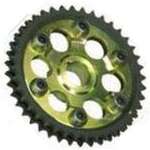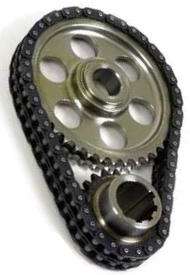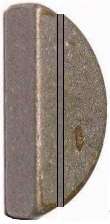The MGA With An Attitude
Cam Timing - ADJUSTABLE SPROCKETS and KEYS -- CM-201C


 So you decided that you just had to have that special camshaft, and maybe it was on sale for just a little more than a standard cam when you needed one. Then when it arrives and you get to read the instructions you discover that it needs a change of cam timing, and you are about bite the bullet and buy some more expensive parts, like an adjustable cam sprocket which might cost as much as the new cam. Before you do that, consider some less expensive alternatives.
So you decided that you just had to have that special camshaft, and maybe it was on sale for just a little more than a standard cam when you needed one. Then when it arrives and you get to read the instructions you discover that it needs a change of cam timing, and you are about bite the bullet and buy some more expensive parts, like an adjustable cam sprocket which might cost as much as the new cam. Before you do that, consider some less expensive alternatives.


At 16:59:24 UK time 17 June 2006, Mark Hester, Perth, Australia (or London, UK) wrote:
"First time I've seen this, USA Moss Part No. 460-388. Quite a bit cheaper than the Kent Cam's vernier set. Has anyone ever seen any lightweight one's of these for racing... Even the Kent kit is very heavy."
I have not see any lightweight cam sprockets. For structural reasons the hub wants to be steel to support the shaft key and retaining nut, and the sprocket teeth want to be steel for wear resistance. For the standard sprocket there is only a thin web in between, and that can be drilled for a small amount of lightening. The adjustable sprocket requires additional parts to allow adjustment, and that will add weight to avoid compromising structural integrity. Trying to build such an assembly to be lightweight could be quite expensive, just to save a few ounces. This part is quite small compared to the mass and inertia of the crankshaft and flywheel.
If you want a lightweight cam sprocket, I suggest you start with a standard sprocket and exercise some standard lightening techniques, such as machining down the perimeter of the center hub, the ID of the outer ring, and drilling the web full of lightening holes. Then you can use other means to adjust the cam timing.
There is nothing radical about the Moss Motors "Adjustable Timing Gear Set". It is just a standard sprocket and chain set with four additional keyways cut in the crankshaft sprocket at 40 degree intervals (picture above). A standard sprocket and chain set is under $50, and any machine shop can cut extra keyways. The same might apply if you can find a lightweight version of the standard sprockets.
The Moss kit has 5 keyways, allowing adjustment up to +/-4 degrees in 2 degree increments. If you skip the chain over one tooth you get +/-9 degrees and you can go +/-4 from there in 2 degree increments. With some fiddling you can have +/- 2, 4, 5, 7, 9, 11, 13, 14, 16, 18, and so on, getting within +/-1 degree of any desired setting. To cover the missing 1 degree steps in between you would need an offset cam key.
If you cut 9 keyways in the crank sprocket (at 40 degree increments) you can adjust around the clock in 1 degree increments. The extra keyways allow up to +/-8 degrees in 2 degree steps. Skip the chain over one tooth on the cam sprocket for +/-9 degrees, and the 8 keyways allow +/-8 from there in 2 degree increments, effectively allowing 1 degree steps at the cam through 360 degrees.


With standard single keyway sprockets, you can use offset cam keys for 1 degree steps up to +/-4 degrees. Combined with skipping the chain over the teeth, this also allows indexing in 1 degree steps around the clock. If you have just a single 3 degree offset cam key in addition to the standard key, you can index in 3 degree increments around the clock, getting within +/- 1.5 degrees of any desired setting.
Offset cam keys may be available with offsets up to 9 degrees, but I would not recommend using the ones with offset greater than 4 degrees. Offset of 1/32 inch gives 3 degrees rotation of the cam sprocket. The standard cam key and slots are 5/32 inch wide. The crankshaft key is 3/16 inch (6/32) wide. The crankshaft key can be milled with 1/32 inch step on each side to produce a cam key with 1/32 inch offset. This leaves a remaining center web in the key 1/8 inch (4/32) wide. This is fine for structural strength, as long as you remember that the key is for location only and not intended to transmit shaft torque. For the driving torque load you need to be sure the camshaft retaining nut is fully tight. If the cam nut works loose even a standard key is doomed to wear and fracture. But a 9 degree offset key would have 3/32 inch offset with only 1/16 inch (2/32) remaining for the center web. I wouldn't trust it not to break in service. Better to work with +/-4 degrees or less for the offset keys and skip the chain over a tooth (+/-9) if you need more than 4 degrees total (9-4=5, etc).
Advantage of the system with the extra keyways in the crank sprocket is that you can do this without using offset keys, and without removing the key from the camshaft, although you do have to remove the sprockets to change cam timing. Advantage of the adjustable cam sprocket is that a cam timing change can be done without removing the sprockets from the shafts, and you have unlimited micro adjustment capability. It might be worth the price if you change the cam timing periodically, but for a single setup the offset cam keys are much cheaper, even if you buy four with different offsets.
|